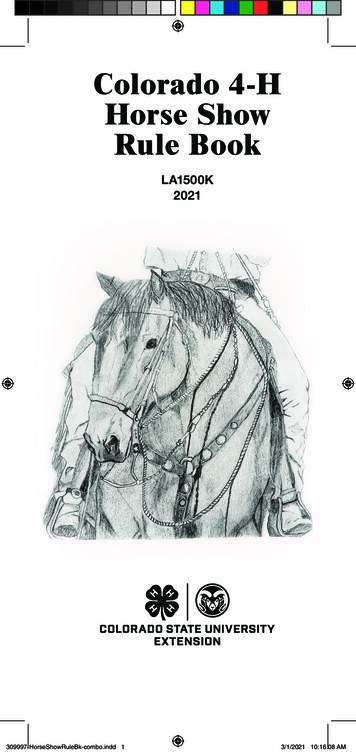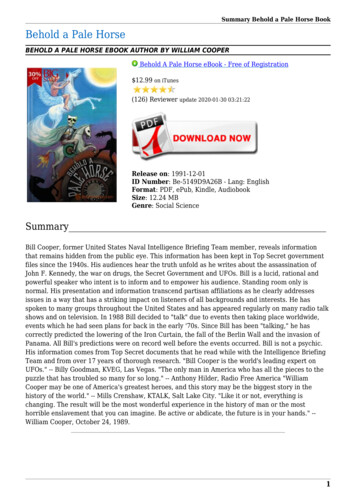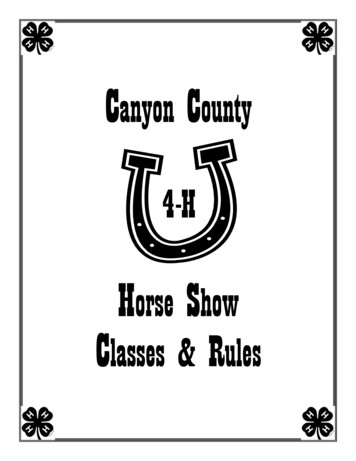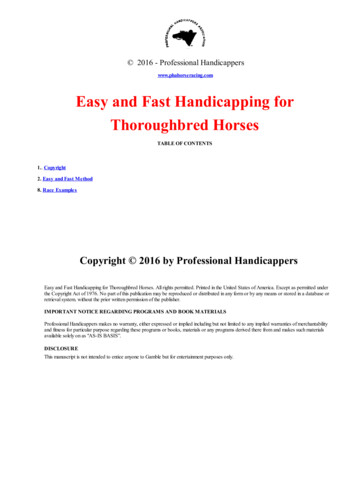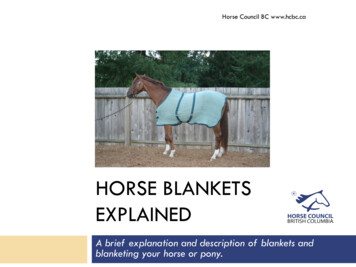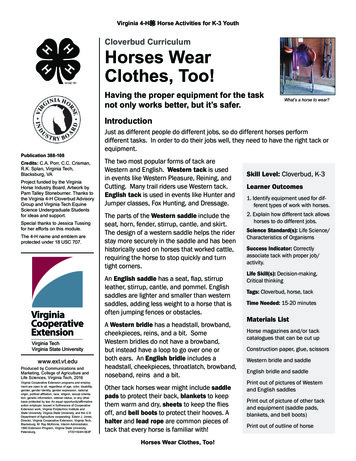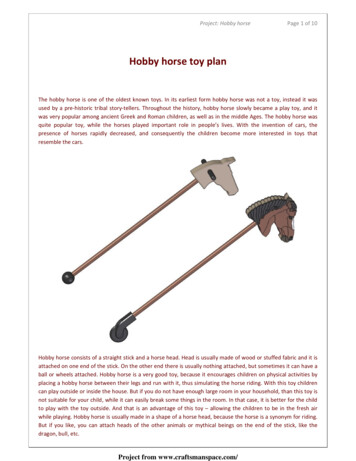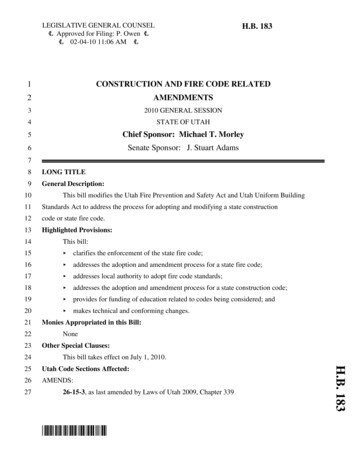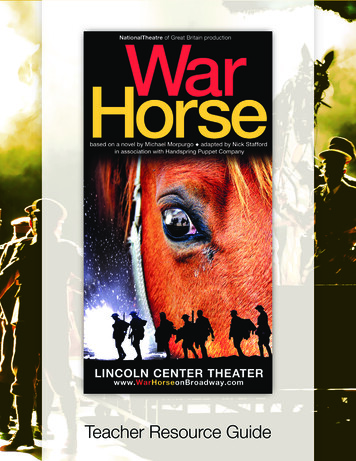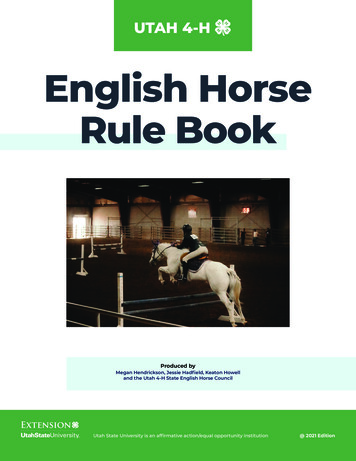
Transcription
UTAH 4-HEnglish HorseRule BookProduced byMegan Hendrickson, Jessie Hadfield, Keaton Howelland the Utah 4-H State English Horse CouncilUtah State University is an affirmative action/equal opportunity institutionUtah 4-H English Horse Rule Book@ 2021 EditionPg 1
I PledgeHEAD to clearer thinkingMy HEART to greater loyaltyMy HANDS to larger service, andMy HEALTH to better living.MyFor my club, my community,my country and my world.Dear 4-H Volunteer and Member:Please report any needed corrections to Megan Hendrickson(megan.rowley@usu.edu), or contact the State 4-H Office.Rule change suggestions should be submitted to the State 4-H English Horse CouncilRules Committee via the State 4-H Office or 4-H English Horse Council President, prior to theSeptember State 4-H Individual Horse Show.*No changes can be made during the competition year expect for clarification or safety reasons.Pg 2Utah 4-H English Horse Rule Book
2021Table of ContentsTable of ContentsSECTION 1 GENERAL . 04General Rules .Attire .Guidelines .Appropriate Tack and Equipment .06091116SECTION 2 HUNTER/JUMPER . 19Hunt Seat Equitation (Pattern Class) . 20Hunt Seat Equation over Fences . 22Hunter Hack . 23SECTION 3 EVENTING . 24Stadium Jumping . 25Dressage . 26Cross Country (except Crickets) . 27SECTION 4 APPENDIX . 29Glossary of Terms . 31Time Fault Guide . 34Scorecards . 35Utah 4-H English Horse Rule BookPg 3
Section 01General InformationSection 01General InformationPg 4Utah 4-H English Horse Rule Book
General InformationSection 01The 4-H Horse Program is designed to emphasize youth development. The horse should be avehicle that reflects the knowledge and skills learned by its rider.Classes which place emphasis upon the horses’ conformation are not included in 4-H HorseContests. Local areas may include these types of classes, but they may not be included in thoseclasses which would be counted toward high point and championship awards.Any horse (light or draft), pony or mule, regardless of breed, type, or quality may be used asa 4-H project animal as long as its soundness does not impair the required performance andcompatibility with the ability of the rider.4-H is open to all youth. To be eligible for enrollment in horse 4-H a youth must be in the 3rdgrade and no younger than 8 years of age by January 1 of that year.4-H involvement as a member will end the summer following high school graduation, or noolder than 19 years of age as of January 1 of that 4-H year, whichever comes first.4-H does not discriminate as to race, color, national origin, disability, religion, or sex of members.4-H OBJECTIVESEncourage youth to:1.Develop leadership abilities, build character, and assume citizenship responsibilities.2. Explore career opportunities.3. Develop skills, knowledge, and attitudes for lifelong use.4. Share knowledge gained with others.5. Acquire skills in horse management by owning a horse of any type (i.e. pony, draft, mule) andbeing responsible for it.6. Appreciate riding as recreation.7.Learn horsemanship skills and understand breeding, training, and raising of horses as abusiness.8. Acquire safety skills to prevent injury to persons and animals.9. Promote love and humane treatment of animals.10. Develop sportsmanship, cooperation, decision-making ability, and public speaking skillsthrough participation in demonstrations, tours, judging, and/or exhibits.Utah 4-H English Horse Rule BookPg 5
General InformationSection 01USE OF NAME AND EMBLEM OF 4-H CLUB WORKThe federal law states that only activities or programs under supervision of the CooperativeExtension Service may use the name and emblem of 4-H club work. Therefore, any local, county,district, area of state 4-H horse contest must have the approval of the Utah State CooperativeExtension Service through county, district, or state personnel.Contests or events sponsored by other organization or individuals, and contests which do notprovide separate classes for 4-H members, are not permitted to use the name and emblem of 4-Hclub work. In such cases, the title, “Junior Horsemanship Contest,” or similar name should be used.GENERAL RULESALL STATE AND REGIONAL 4-H HORSEMANSHIP CONTESTS WILL ABIDE BY THESE RULES:1.Club and county contests are encouraged to follow these rules for competition. Contestcommittees and leaders should make every effort to inform all members, leaders, parents,and judges of rules to be used, especially if they vary from state rules.2. At all 4-H contests each 4-H member must provide the horse he/she uses. The horse maybe leased or borrowed, providing the member has access to the horse at all times duringthe project year and has major responsibility for its care and maintenance. This does notnecessarily include financial support. This rule applies to Western, Two-Handed, and Englishproject horses.3. After arrival at the show the 4-H exhibitor will be the only individual that rides the horse untilall events are complete. Violators will be disqualified from the show in its entirety.4. At all State 4-H Contests, the limit is one horse per person and one person per horse. Situations requiring a substitution of the project horse or alternate horse and rider,should be cleared through the County Horse Council with Extension Agent inputgrievances regarding state 4-H Horse Show eligibility and may be referred to the State4-H English Horse Council for a final decision. Each County needs to have by-laws and rules to avoid unnecessary misunderstandingsregarding qualifications and substitutions that my be required.5. The 4-H member’s project is centered around one primary project horse, but additionalhorses may be used for breeding, two-handed training classes, Western competition, colttraining, trail riding, etc.6. A 4-H member will be disqualified from an event and awarded an orange ribbon forverbal or physical abuse of people or horses committed by the 4-H member or any familymember or associate.7. All participants in 4-H contests will receive blue, red, or white ribbons. Those disqualifiedfor breaking patterns or having an abusive performance or other violations specified inthis Utah 4-H English Horse Rule Book will receive an orange ribbon. A broken pattern (notdoing an obstacle/maneuver or not doing the pattern in the correct order) in any event, willbe a disqualification.Pg 6Utah 4-H English Horse Rule Book
Section 01General Information8. A primary objective of the 4-H English Horse Program is for youth to learn horsemanship and todo their own training. If a horse needs to be taken to a professional trainer for special purposes,the youth should be trained with the horse.9. Stallions of any age are prohibited in 4-H classes.10. It is recommended that 4-H Horse Show judges be selected from the 4-H Horse ShowJudging List and/or the USU Certified Horse Show Judges list. Current 4-H Judges areencouraged to attend judges training at least every other year. New 4-H Horse Show Judgesfrom either pool are encouraged to apprentice a minimum of two shows before judging soloas the official show judge.11. Any exhibitor falling from the horse during any event will receive an orange ribbon anddisqualification, with no re-ride.12. Any equipment (tack) failure in any event resulting in the riders’ inability to complete the eventshall receive an orange ribbon and disqualification, with no re-ride.13. Abusive use of bats, spurs, whips, reins, will result in disqualification and the awarding of anorange ribbon. This applies to all events. See Exhibitor Behavior, rule 2 for definition of abuse.14. All timed events will be timed start flag to finish flag. That is, the clock will start when thehorse’s nose crosses the starting line and will stop when the horse’s nose crosses the finish line.At least two stop watches will be used during each event.15. A start and finish line must be clearly indicated by cones or markers. The cones or markersshould be set as wide apart as arena conditions will allow. Horse and rider must pass betweenthe cones to start and finish the event or an orange ribbon will be awarded.16. When an exhibitor allows his/her horse to cross the finish line before finishing the pattern, it willbe considered a broken pattern with no time and an orange ribbon will be awarded.17. At State and Region Contests, exhibitors will receive a number which will be pinned to therider’s back or a bridle number which may be attached to horse’s bridle. If a contestant doesnot have a number it is a ribbon dropUtah 4-H English Horse Rule BookPg 7
General InformationSection 0118. In any class the judge may direct any exhibitor to repeat or perform additional maneuvers.19. A red ribbon in a horse’s tail indicates that the horse may kick. A red ribbon in a horse’smane indicates that the horse may bite. A horse that has the appropriate red ribbon(s)attached, that bites or kicks at an approaching horse, will not be penalized for such actions.Always keep a horses length spacing when approaching an identified horse.20. Unsafe behavior by a 4-H member, any family member, or associate on the show groundsmay be cause for disqualification of the 4-H member from further competition in the eventor show, at the discretion of the show committee. The following are considered unsafebehavior: Double riding anywhere on the show grounds. Riding a horse without a bridle or hackamore. “Horse play” activities on or around horses.21. All 4-H exhibitors must take the written test to be eligible to compete in the other eventsof the show.22. Anyone missing their gate call in any event without pre-approval from the show committeeor management, will show at the end of the class and be penalized 1 ribbon placing fromthe placing awarded.23. Utah 4-H will hold two state-wide English Horse Shows each year. One will be a Huntertype show and one will be and Eventing type show. The Events for each show areindicated below.Hunter Show Pg 8TestHunt Seat EquitationHunt Seat Equitation over FencesHunter HackEventing Show TestStadium JumpingDressageCross-Country (Except Crickets)Utah 4-H English Horse Rule Book
Section 01General InformationATTIRE1.A 4-H patch — must be worn on the upper left sleeve.must be visible during the event. No patch or patch nota ribbon drop in judged events and a 5 second penaltyevents. Other acceptable patches include any patchfor purchase through the 4-H mall that includes a bigThese are available online at https://shop4-h.org.Patchesvisible isin timedavailableclover.2. HELMETS — The Utah State 4-H Office highlyencourages the use of helmets during all equestrian events. Effective January 2011,helmets will be required for all western under saddle and bareback events occurring at 4-Hsponsored horse shows. Helmets must be approved by the American Society for Testingand Materials (ASTM) and Safety Equipment Institute (SEI) and worn with harness fastenedproperly under the chin. Riders without helmets will be disqualified from the show. Helmetsare required anytime you are mounted on your horse at a 4-H event.3. HUNTER ATTIRE — Riders should wear hunter style attire including a hunt coat of tweedor dark solid color, a shirt of conservative color, with stock and pin, or ratcatcher, or tie, andEnglish style breeches or jodhpur pants. A tan color is preferred, but not required. A belt isrequired, but is not to be of western style. Appropriate Hunter Attire Combinations: Breeches with tall english/western riding bootsBreeches with paddocks boots or western riding boots and half chaps of anymaterial (suede, smooth leather, etc.)Jophurs with paddock boots and garters or western style riding bootsSpurs of the unroweled type with a maximum length of 1 ½” and crops or bats areoptional but crops and bats are not to exceed 30” in length including the lash. Hairneeds to be tied back, off the face, under the helmet (bun, braid, etc.)In extreme weather conditions the judge may allow exhibitors to compete withoutjackets. Extreme weather conditions include temperature above 85 F, or a heat indexabove 85 F, or at the discretion of the judge/show committee exhibitors can competewithout jackets. However, shirts must have sleeves and no ratcatcher collar or stocktiesare permitted. Sleeveless is prohibited. In the event of an exhibitor having a sleevelessshirt, the jacket must remain on.Utah 4-H English Horse Rule BookPg 9
General InformationSection 014. STADIUM JUMPING — Full English gear is required. See #3 above.5. DRESSAGE — Full English gear is required. See #3 above.6. CROSS COUNTRY — A collared shirt with sleeves (short or long) is mandatory. The shirt maybe a polo or other collared shirt. A body protecting vest that passes or surpasses ASTM’sstandards (F1397) must be worn during warm up and cross country phrase. Spurs of theunroweled type with a maximum length of 1 ½” and crops or bats are optional but cropsand bats are not to exceed 30” in length including the lash. Hair is to be secured either in abun or a braid at the base of the neck or under the helmet. American Standard for TestingMaterials (ASTM) approved headgear, worn with harness fastened under chin, is required.7.EXCEPTIONS — Because 4-H is open to all youth regardless of race, color, national origin,sex or religion, religious restrictions of certain types of clothing will be accepted. In suchcases where deviations from 4-H dress standards are necessary, the contest managementshould make the judge aware that at no time will points be discounted for religious dressrestrictions, such as culottes in place of English style pants.8. ARENA HELP — It is desirable for all persons in the arena acting in capacity of exhibitor,steward, judge, timers, score keepers, etc., to wear long or short sleeved English shirts andlong pants. Tank tops, pullovers, or sweat shirts do not present a desirable image to thepublic or participants.9. AWARDS DRESS CODE — Appropriate dress is required when receiving awards.Pg 10Utah 4-H English Horse Rule Book
Section 01General InformationGUIDELINES1.All horse’s hooves should be properly trimmed or shod for all 4-H activities.2. Hoof paint/polish is optional and is not more desirable than clean unpainted hooves. A goodclean well-groomed hoof is the main objective.3. 4-H members, leaders and parents are encouraged to make use of 4-H video tapes andother audiovisual materials to help them better understand events, rules and how toperform at their best.4. A written test will be given at every 4-H horse contest to help encourage the educationalcomponent of the 4-H horse program. All test questions will be limited to horse and EnglishDiscipline related topics.5. Simple lead changes: When simple lead changes are allowed, exhibitors are limited to onlythree trot steps to make the lead change.6. All participants are encouraged to wear a medical arm band or bracelet on the rightarm or leg.7.All English State and Region horse shows will be subject to the Utah 4-H Biosecurity policy.8. All facilities used for events, shows etc. are used at your own risk. All event locations shouldhave a sign posted that says the following:NOTICE: USE THIS FACILITY AT YOUR OWN RISK.There are inherent risks of participating in equine or livestock activities. “Inherentrisk” with regard to equine or livestock activities means those dangers or conditionswhich are an integral part of equine or livestock activities, which may include:(a) the propensity of the animal to behave in ways that may result in injury, harm, or death topersons on or around them;(b) the unpredictability of the animal’s reaction to outside stimulation such as sounds,sudden movement, and unfamiliar objects, persons, or other animals;(c) collisions with other animals or objects; or(d) the potential of a participant to act in a negligent manner that may contribute to injuryto the participant or others, such as failing to maintain control over the animal or not actingwithin his or her ability. See Utah Code 78B-4-201(5) and 78B-4-203.The sponsor of equine or livestock activities occurring within or connected to thisfacility is not liable for (i) Inherent Risks or (ii) any injury, death, illness, disability, ordamage to persons or to property arising from Inherent Risks.Utah 4-H English Horse Rule BookPg 11
General InformationSection 01EXHIBITOR BEHAVIOR1.Good sportsmanship shall prevail at all times. No abuse of animals or people will bepermitted by a 4-H member, any family member, or associate. Abusive behavior of this kindwill be cause for disqualification of the 4-H member from further competition in the eventor show at the discretion of the show committee.2. Bats can only be used in this manner according to USEA: “The whip/crop must be usedeither as an aid to encourage horse forward, or as a reprimand, It must never be used tovent a rider’s temper. Such use is always excessive. As a reprimand only, a horse may neverbe hit more than three times for any one incident. If a horse is marked by the whip, e.g. theskin is broken, it’s use is excessive. Excessive use of whip/crop will result in disqualificationand the awarding of an orange ribbon. A horse can be corrected without abuse.”3. Administering performance altering drugs or substances to horses is also considered abuse.4. Contest officials and grievance committee will determine disqualifications.5. Complaints of abuse must be made immediately to contest officials or grievancecommittee and then followed with a written statement. Infractions can be more effectivelycontrolled if handled in a timely manner.6. Complaints regarding procedures must be made in writing accompanied by 25.00 in cashto contest officials or grievance committee. No cameras or any type of video camcorderswill be accepted to substantiate a grievance. The money will be refunded only if thegrievance committee acts in favor of the complaint.7.It is highly inappropriate to confront a judge about a class or placing outside of the arenaafter the judge has turned in their scoresheet to show management. Only youth shouldapproach the judge to ask questions and should be polite and willing to learn.Pg 12Utah 4-H English Horse Rule Book
Section 01General InformationUTAH 4-H EQUINE DRUG RULEThe use of systemic non-steroidal anti‑inflammatory agents (i.e., phenylbutazone,meclofenamic acid, naproxen, etc.) or antihistamines are considered permissible if: Their use is declared and supported by documentation from a veterinarian upon arrivalat the show;The veterinarian verifies the necessity of their use for a specific problem; andThe veterinarian verifies that their use will not in any way jeopardize the horse’s wellbeing or provide an unfair advantage over other competitors. The letter must bepresented to the show chairperson by the competitor on arrival at the show.The veterinarian’s decision, if requested by a judge or the show chairperson, as to theserviceable soundness of a horse shall be final. In the absence of a veterinarian, the judgeor show chairperson shall have the right to excuse a horse from further participation on thegrounds of unsoundness. That decision shall be final. Horses must arrive at the show free ofmedication, or have a letter from their veterinarian.Definition of “Serviceably Sound”: The horse that is able to perform at every gait that isrequested which is – walk, jog/trot, lope/canter at both leads and back effectively, is consideredserviceably sound.No horse may be used in any competition or class if it has been administered a stimulant,depressant, tranquilizer, or any other drug which may stimulate or depress its circulatory,respiratory, or central nervous system. Any or all horses participating in the show may be testedby a saliva, blood, and/or urine test for controlled substances.Drug testing may be done at any 4-H show. Horses will be selected at the show committee’sdiscretion. Failure to comply with the above equine drug regulations may result in immediateor subsequent disciplinary action. Penalties may include, but are not restricted to, dismissalfrom a class, a contest, and/or the Utah 4‑H Horse Program.THREE-MEMBER GRIEVANCE COMMITTEEA three-member grievance committee will consist of people from the State English HorseCouncil and the State appointed Technical Delegate. Committee members should becompletely familiar with all 4-H English Contest Rules.The purpose of this committee is to: React to written protests;Watch for and react to abusive behavior towards horses or people by parents,exhibitors, guardians, helpers or horse handlers inside or outside of the arena; andWatch for and react to the administering of performance altering drugs or substances.NO SHOW OR GRIEVANCE COMMITTEE MAY ALTER A JUDGE’S PLACINGUtah 4-H English Horse Rule BookPg 13
General InformationSection 01ENGLISH SHOW INFORMATION:At the English Show each class will be placed on the DANISH SYSTEM (Blue, Red, White, andOrange) and place the top five.Exhibitors will show in a level according to ability. The divisions are Cricket, Grasshopper, PreNovice, Beginner Novice, Novice, and Training.Cricket are walk/trot classes only.Grasshopper will be walk/trot only on the flat. Grasshoppers will have the option to canter inany jumping class.Cricket division will be limited to 3rd - 5th graders only. Grasshopper (Intro) division willbe divided into two separate age divisions: Grasshopper A is for youth in 3rd-7th grade.Grasshopper B is for youth in 8th-12th grade.Seniors and Intermediates may submit a request to show in the cricket division that will bereviewed by the committee appointed by the youth development specialist. Committee willdetermine if the requester will be evaluated over fences.If rider is observed jumping at a skill level that the technical delegate classifies as “unsafe,” thetechnical delegate will evaluate the rider and place in an appropriate division.4-H will offer “concours avec honneur” for any English rider that has competed in local, regionalor National English or Western events, above the Intro (Cricket and Grasshopper (Intro) inEnglish or Novice in 4-H Western) levels. These classes will be specifically for membersshowing a “green” or inexperienced horse at the show. The points for this horse and ridercombination will not be tallied into the regular classes for overall placings at the show, but isintended to allow the horse to gain experience at the introductory levels.Pole height will be measured from the ground to the top of the pole. Pole width will bemeasured from outside to outside of the jumping standard.In over fences classes an exhibitor will compete at the same height in all classes at any givencontest. Exhibitors will be evaluated for over fences classes and assigned an appropriate levelby an approved evaluator. To jump a lower course the exhibitor must be:1. Using a different less experienced horse;2. Given permission by an approved evaluator ;3. Given permission by the 4-H volunteer chairperson of the county horse program.A different horse may be used for English Performance than used for Western Performance.Pg 14Utah 4-H English Horse Rule Book
Section 01General Information4-H COMBINED TRAININGA combined training event includes two or three tests from the following branches ofequitation: dressage, stadium jumping and/or cross country. It is required that horses be over 5years old when entered in jumping classes.Disqualification in one phase of 4-H Combined Training does not eliminate an exhibitor fromparticipating in a succeeding phase. However, if the safety committee in one phase rules thatan exhibitor is unsafe to continue to a succeeding phase, the exhibitor will be eliminated. Thecommittee is encouraged to eliminate unsafe competitors.UNAUTHORIZED ASSISTANCEAny intervention by a third party, whether solicited or not, with the object of facilitating the taskof the exhibitor or of helping the horse will result in the disqualification of the exhibitor. Thisincludes help with pace, obstacles, or any other difficulties between horse and rider. Applauseand/or praise to a rider is considered acceptable if no help is offered. Unauthorized assistancewill result in the rider being excused for the remainder of the class.EXCEPTIONSAfter a fall or if an exhibitor dismounts, she/he may be assisted to catch the horse, to adjustthe saddle, to remount or be handed any part of the saddle or equipment while dismounted orafter remounting. Whip, headgear or eye wear may be handed to an exhibitor.At the start of cross country the exhibitor may be assisted by a third partyLevel 1: CRICKETSLevel 2: Grasshopper A & BTo trot over poles on ground. (If can Jumping up to 18 inchesbe arranged - crickets will be alSpreads: No spreadlowed to go over poles on ground/or jumps not to exceed 12 inches.Event will be based on an optimumtime set by course designer.)Jumping up to 2 feet, 3 inchesSpreads not to exceed 2 ft, 11 in18 inchesLevel 4: BEGINNER NOVICEJumping up to 2 feet, 7 inchesSpreads not to exceed 3 ft, 3 in2 feet7 inchesUtah 4-H English Horse Rule BookLevel 3: PRE-NOVICELevel 5: NOVICEJumping up to 2 feet, 11 inchesSpreads not to exceed 3 ft, 7 in2 feet11 inches2 feet3 inchesLevel 6: TRAININGJumping up to 3 feet, 3 inchesSpreads not to exceed 3 ft,11 in3 feet3 inchesPg 15
General InformationSection 01APPROPRIATE TACK AND EQUIPMENTHUNTER CLASSESBRIDLES — with regulation snaffles, and full bridles, all with cavesson nosebands (seeillustration on page 13). If the class requires that exhibitors return to the ring to jog forsoundness they must use the same complete bridle in which they have performed. Noflash, dropped or figure eight nosebands are allowed.MARTINGALES — are not allowed in flat classes. In Hunter Over Fences classes, a standingmartingale or breast collar/plate is permitted. A running martingale is not allowed.BOOTS OR WRAPS — are prohibited in Hunter classes. If weather is inclement, contestofficials may permit the use of bell boots. A rider may ask for permission for boots orwraps based on the safety and comfort of the horse. The request must approved by theshow committee and/or judge.SADDLE — A hunt seat saddle with a forward flap (fender) is required. Western, Australian,Saddle Seat, Park Seat and Dressage type saddles are not suitable.SPURS — of the unroweled type are acceptable not to exceed 1 ½” in length.CROPS OR BATS — are optional not to exceed 30” in length including lash.STADIUM/CROSS COUNTRYBRIDLES — with regulation snaffles, and full bridles, all with cavesson nosebands (seeillustration on page 13). If the class requires that exhibitors return to the ring to jog forsoundness they must use the same complete bridle in which they have performed. Flash,dropped or figure eight nosebands are allowed.MARTINGALES — Standing Martingales are not allowed. A running martingale orbreast collar/plate that is not fixed may be allowed in Cross Country. All runningmartingales must have rein stops.BOOTS OR WRAPS — are allowed.SADDLE — An English type saddle is required. Dressage style saddles are not to bepermitted.SPURS — of the unroweled type are acceptable not to exceed 1 ½” in length.CROPS OR BATS — are optional not to exceed 30” in length including lash.Pg 16Utah 4-H English Horse Rule Book
Section 01General InformationDRESSAGEWHIP — One whip no longer than 3 feet including the lash may be carried except forclasses ridden for Combined Training.SPURS — Of the unroweled type are acceptable not to exceed 1 ½” in length.BITS — An English snaffle (no shank), all with cavesson nosebands and plain leather browbands must be used. Brown bands can have “bling.”In reference to mouthpieces, nothing mayprotrude below the mouthpiece (bar). Solid andbroken mouthpieces must be between 5/16” to¾” (8 mm to 20 mm) in diameter, measured 1”(25 mm) from the cheek and may have a port nohigher than 1 ½” (40 mm). They may be inlaid,synthetic wrapped, including rubber or plasticor encased, but must be smooth. On brokenmouthpieces only, connecting rings of 1 ¼” (32mm) or less in diameter or connecting flat barof 3/8” to ¾” (10 mm to 20 mm) measured topto bottom with a maximum length of 2” (50mm), which lie flat in the horse’s mouth, areacceptable. Snaffle bit rings may be no largerthan 4” (100 mm) in diameter. Any bit having afixed rein requires use of a curb chain. Smoothround, oval or egg-shaped, straight bar or solidmouthpieces are allowed.DRESSAGESADDLE — An English type saddle with stirrups must be used.BRIDLE — A plain snaffle bridle is mandatory along with theuse of any of the following nosebands: a regular cavesson,a dropped noseband, a flash noseband, or Figure 8 madeentirely of leather.MARTINGALES — of any kind are not allowed. Breast plates/collars are permitted.BOOTS AND BANDAGES — are not permitted.Utah 4-H English Horse Rule BookPg 17
General InformationSection 01CROSS COUNTRY COURSEThe cross country course will be closedto all exhibitors on the same day.After that date and prior to the actualcompetition exhibitors may not jumpany obstacle or ride close enough toshow their horse the obstacle.RED AND WHITE MARKERSThe exhibitor must pass betweenflags, plates, or other delegatedmarkers posted on each stadiumjumping an
Pg 2 Utah 4-H English Horse Rule Book Dear 4-H Volunteer and Member: Please report any needed corrections to Megan Hendrickson (megan.rowley@usu.edu), or contact the State 4-H Office. Rule change suggestions should be submitted to the State 4-H English Horse Council
